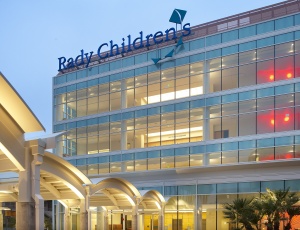More than two weeks ahead of schedule, McCarthy Building Cos. Inc. has completed construction of the new 279,000-sq-ft Rady Children�s Hospital Acute Care Pavilion in the Kearny Mesa area of San Diego.

Designed by the San Francisco office of Anshen+Allen, the new $260-million Acute Care Pavilion is the first acute care facility in the state to meet the rigorous standards for quality and safety mandated by the Office of Statewide Health Planning and Development (OSHPD), while also achieving the level of occupant health and environmental sustainability required to earn LEED-certified status. The facility will be equipped and staffed to receive patients on Oct. 10.
�Construction oversight of OSHPD facilities adds a heightened level of complexity to already complicated healthcare construction projects in California, based on the state�s strict criteria for passing project inspections, reviews and approvals,� says Dan Stone of CCQA Inc., inspector-of-record for the project. �McCarthy skillfully managed the many construction details to meet the agency�s high standards.�
For the Acute Care Pavilion, Rady Children�s Hospital employed one onsite inspector-of-record and three field inspectors, bound to the letter of the law. McCarthy says it served the integral role of working through all construction issues, developing proactive solutions, documenting every discussion and construction activity, and communicating with OSHPD inspectors, who visited the site three times a week. Not a single detail of the project could afford to be overlooked, from the drilling operation that involved the installation of individual 60-foot-deep by eight-inch-wide holes to accommodate seismic tie-down rods, to the torque of each bolt, says McCarthy. Building information modeling allowed the construction team to address many of the seismic issues. Rady Children�s Hospital is the only dedicated child-specific medical center in the San Diego region, and demand for services had outgrown its existing facilities. The new pavilion was built on a tight, 148,650-sq-ft site at the southeast end of the hospital campus, adjacent to the existing Rose Pavilion. Second- and third-floor bridges and a ground-floor walkway connect the existing facility to the new four-story building.
When equipped, the Acute Care Pavilion will house a much-needed surgical center, 84 medical-surgical beds, a neonatal intensive care unit (NICU), and a cancer center. It also will provide 16 operating rooms with associated support departments, a 28-bed hematology and oncology unit, and a 10-bed bone marrow transplant intensive care unit.
The facility�s exterior features a glass-fiber reinforced, precast concrete exterior; integral-colored plaster; storefront and curtain wall glass systems with colored accents; metal panels and railings; and a billowing steel front entry canopy carrying the hospital�s �kite� insignia.
To knowledgeably address the LEED aspects of the project and carry through the facility�s sustainable design in a thoughtful, practical manner, McCarthy says it employed a dedicated LEED accredited professional and, since the project began in early 2008, 10 of the construction team's members have become LEED APs.
Working in accordance with LEED 2.1, the project team is on track to receive 31 of the 25 points needed to become LEED Certified. McCarthy says it is in the process of submitting the construction documentation needed for official certification.
The new Rady Children�s Hospital Acute Care Pavilion has earned an �Innovation in Design� credit for the introduction of a series of healing gardens that utilize sustainable design principles and embrace the hospital�s healing arts program, which originally was developed in 1993 in conjunction with the Rose Pavilion construction. Named �Carley's Magical Gardens,� these playful, landscaped areas were designed through the collaboration of local artists T.J. Dixon, Kim Emerson, Albert De Matteis and James Nelson. The first floor garden off the main entry, intended for use by parents and siblings, sets the stage for the whimsical themes experienced throughout the facility.
Located on the second floor off the hematology and oncology unit, the primary healing garden features a giant, tiled bird with a place for patients to deposit their wishes, which staff will later collect in order to better understand the children�s wants and needs. On the third floor is a landscaped bamboo garden with a rubber-surfaced playing area for patients and a retreat area for staff members. A vast ground-floor outdoor terrace, strictly for staff use, features Jacaranda trees, white light posts and bike racks.
The project team achieved 23% below Title 24 requirements for energy efficiency by utilizing the LEED Energy Cost Budget methodology. This was achieved by incorporating: 1) occupancy sensors in operating rooms to reduce the ventilation rate by 60% when unoccupied, yielding a 45% annual energy savings; 2) variable frequency drives on air handling unit motors to adjust the fan speed due to filter loading; 3) carbon dioxide monitoring for high occupancy areas to reduce ventilation rates, based on the number of occupants; 4) a supply air temperature reset strategy, which saves energy by adjusting air temperatures based on load; 5) a 24,000-sq-ft cogeneration plant that provides free heating and high temperature water, and contains two 700-ton natural gas-fired absorption chillers; and 6) variable frequency drives on cooling tower fans and hot water pumps.
The project also utilizes recycled and locally obtained steel, concrete and other building materials; low VOC-emitting paints, glues, carpet, and wood; water-efficient landscaping; abundant daylighting, even at operating rooms; and a dedicated bicycle storage area. A reflective concrete �cool roof� system helps minimize heat gain and control rainwater run-off, and painted steel screens conceal rooftop mechanical systems.
Nearly 80% of construction waste materials at the job site was recycled. The project team went above and beyond the LEED requirements by declaring the entire hospital campus a �no smoking� zone. A thorough, 14-day flush-out of the building began upon construction completion.
KPFF of San Francisco served as the structural engineer; RBF, San Diego, civil engineer; Randall Lamb, San Diego, electrical engineer; Shadpour Consulting Engineers, San Diego, mechanical engineer; and Royston Hanamoto Alley & Abey of Mill Valley was the landscape architect.

Post a comment to this article
Report Abusive Comment